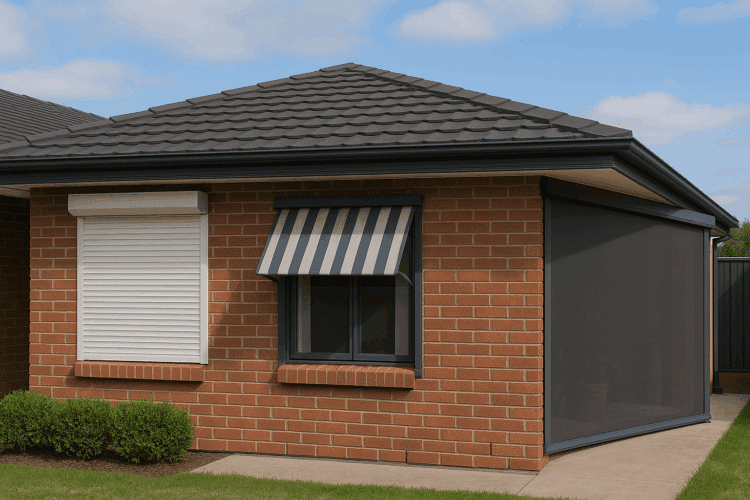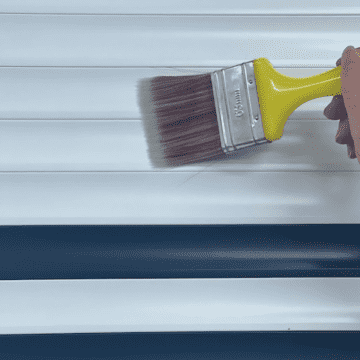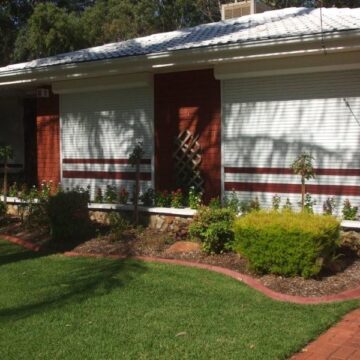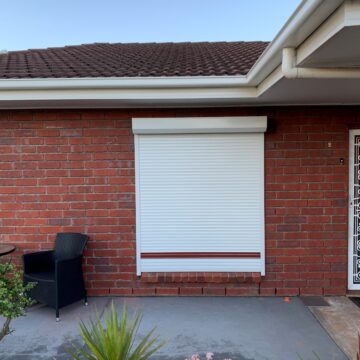Rolling window shutters—often just called roller shutters—are sturdy, interlocking aluminium slats that roll up and down over your windows. Housed neatly in a slim pelmet, they can be operated by a winder, strap, battery, solar panel or electric motor. Fitted outside the frame, they add a strong layer of security, shut out light and noise, and help keep Adelaide homes cooler in summer and warmer in winter. They’re popular across South Australia for energy savings, privacy and protection in harsh weather.
This guide cuts through the jargon to help you choose the right setup for your place. We’ll explain manual, electric and battery/solar options, give realistic Adelaide price ranges (including DIY kits and upgrades), and show what drives costs—like window size, slat profiles and site access. You’ll learn when DIY makes sense, what tools you need, and when to call a pro. We also cover smart controls, repairs and conversions, bushfire and security considerations, design choices, lead times, warranties and where to buy locally versus online. Let’s get you a clear, local answer.
Benefits in Adelaide’s climate: security, insulation and comfort
Adelaide’s summers are hot and bright, with long heatwaves and fierce western sun; winters bring chilly nights and brisk winds. Rolling window shutters add a tough aluminium barrier at the glass, improving security while creating an insulating air gap that slows heat transfer. Foam-filled slats and snug side guides help keep living areas cooler in summer and hold warmth in winter, while blackout control boosts sleep and reduces glare across west- and north-facing rooms.
- Security boost: Interlocking aluminium slats and full-window coverage act as a strong visual and physical deterrent.
- Summer cooling: Reduce heat gain and strain on air conditioning on scorching days.
- Winter warmth: Cut drafts and heat loss for cosier nights.
- Noise and light control: Darken bedrooms, improve TV rooms and soften traffic or neighbour noise.
- Weather protection: Shield glass and frames from wind-driven rain, debris and harsh UV.
- Privacy on demand: Enjoy street-front living without feeling on display.
Manual vs electric vs battery/solar: choosing the right operation
How you operate rolling window shutters shapes day‑to‑day convenience, installation complexity and long‑term maintenance. Think about window size, access (upstairs or hard-to-reach), who’s using it, and whether you can run cabling. In many Adelaide homes a mix works best: manual for small bedrooms, electric for larger living zones, and battery/solar for tricky retrofits.
- Manual (strap or winder): Lowest cost and simple, with no wiring. Great for small to mid‑size windows. Requires some effort to open/close, and straps/gearboxes can wear over time.
- Electric (mains powered): Smooth, push‑button control via switch or remote; ideal for bigger spans and frequent use. Needs a licensed electrician for wiring and compliance, and pairs well with future smart upgrades.
- Battery/solar: Fast retrofit with no mains wiring; a compact battery drives the motor and a small panel trickle‑charges it. Perfect where cabling is difficult. Performance depends on sunlight and batteries will eventually need replacement.
Price guide in Adelaide: DIY kits, manual, electric and upgrades
Adelaide pricing for rolling window shutters depends on opening size, operation type, finish, and how tricky the install is (single-storey vs two-storey, access, scaffolds). Use the guide below to gauge relative costs, then get a fixed quote for your windows or floor plan.
- DIY kits (manual): Lowest-cost path if you’re confident measuring and fixing off the guides and pelmet yourself.
- DIY kits (electric): Add the motor and controls to the kit price; a licensed electrician is required for mains wiring in SA. Still a strong value play if you handle the carpentry and scheduling.
- Supply and install (manual): Entry-level installed option; good for small to mid-size windows and budget-conscious upgrades.
- Supply and install (electric): Higher due to motor hardware, wiring, and commissioning; best for larger spans and everyday convenience.
- Battery/solar systems: Typically sit between manual and electric on total outlay; no mains wiring, ideal for retrofits where cabling is hard.
- Upgrades and repairs: Converting manual to electric or replacing a worn motor is usually more economical than full replacement if the curtain, guides and pelmet are sound.
- Multi‑window packages: Per‑window rates often improve when ordering several shutters together.
What affects the cost: window size, materials and site access
The price of rolling window shutters in Adelaide is driven by the amount of aluminium, the hardware you choose and how easy the install is. Bigger spans need larger pelmets and stronger axles; electric setups add motors and licensed electrical work. Finishes, compliance extras and multi‑storey access can also shift labour and materials.
- Window size and span: More aluminium, bigger pelmet, stronger axles.
- Slat type: Foam‑filled domestic vs extruded security profiles.
- Finish: Standard colours cost less than custom powder‑coat.
- Operation: Manual is cheapest; battery/solar; electric adds motor and electrician.
- Site access: Two‑storey, tight access, scaffolds and wall type.
- Extras/compliance: Bushfire ratings, keyed switches, sensors and integration.
DIY roller shutters: tools, measuring and common pitfalls
DIY rolling window shutters can save money if you’re handy and comfortable working at height. The keys are accurate measurements, square and plumb guides, and using the right fixings for your wall. For mains‑powered motors, South Australia requires a licensed electrician for wiring; plan this before you order.
- Tools: Tape measure, spirit level, square, drill/driver, masonry/metal bits, rivet gun, sealant and applicator, appropriate fixings/anchors, PPE, ladder/trestles.
- Measuring essentials: Decide face‑fix vs reveal‑fix; measure width and height in three spots and note the smallest; check sill level and wall plumb; confirm pelmet space above; record left/right control location; follow your supplier’s deduction sheet.
- Site checks: Identify wall substrate (brick, concrete, timber, steel), locate services, note access for upper storeys, and ensure power/solar exposure if applicable.
- Common pitfalls: Mis-measuring, out‑of‑square guides causing binding, wrong fasteners, drilling into services, skipping sealant, installing pelmet too tight to eaves, and not test‑running the curtain before final fix‑off.
Professional supply and installation in Adelaide: process and timelines
If you prefer a turnkey result, professional supply and install delivers precise measuring, compliant wiring and a clean finish—especially on upper storeys. In Adelaide, many shutters are manufactured locally, so once your selections are locked in the process is straightforward and communication is easy if anything on site changes.
- Consult and measure: An in‑home visit (or floor‑plan quote for new builds) to confirm sizes, fix type, colours and operation (manual, electric or battery/solar).
- Detailed quote: Itemised options and any access allowances (two‑storey, scaffolds) plus electrical scope if required.
- Pre‑install check: Final site review, switch/remote locations, and scheduling of a licensed electrician for mains‑powered motors (as required in SA).
- Manufacture: Cut‑to‑size curtains, pelmets and guides produced to your specs.
- Installation day: Guides fixed plumb, pelmet mounted, limits set, test run and weather‑sealing applied.
- Handover: Controls paired, user training, care tips and warranty documentation.
Timelines depend on seasonality, number of openings, colour selections, access, and electrical readiness. Weather and multi‑storey work can affect booking dates, so lock in your slot early where possible.
Electric and smart controls: motors, remotes, apps and voice control
Electric operation takes the effort out of rolling window shutters, giving smooth, fast movement and simple control of single windows or whole rooms. Motors are neatly housed in the axle, and can be paired to a wall switch or handheld remote; add a smart gateway to unlock app control, automations and voice commands. For mains‑powered systems in South Australia, a licensed electrician must complete the wiring and commissioning.
- Mains‑powered motors: Best for larger spans and frequent use; wired and certified by a licensed electrician in SA.
- Controls: Wall switches, handheld remotes, or both; set groups for one‑touch all‑up/all‑down.
- Smart hub/app: Add a compatible gateway to control via phone, set schedules, sunrise/sunset routines and holiday mode.
- Voice control: Integrate with popular assistants for hands‑free operation.
- Resilience: Local switches/remotes still work if your Wi‑Fi is offline.
Repairs and upgrades: convert manual to electric, replace motors and parts
If your rolling window shutters are tired rather than terminal, upgrading beats replacing. In many Adelaide homes you can keep the curtain, guides and pelmet, then retrofit a tubular motor with a wall switch or remote for smooth electric control. Where wiring is tricky, battery/solar motors are a neat alternative. For mains‑powered conversions and motor swaps in South Australia, a licensed electrician is required. A good repair assessment checks for worn straps, noisy gearboxes, sluggish motors, bent slats and mis‑set limits before recommending targeted fixes.
- Convert manual to electric: Retrofit motor, add switch/remote, set limits.
- Replace tired motors: Like‑for‑like changeover to restore performance.
- Strap and gearbox swaps: Fix heavy, uneven lifting on manuals.
- Slat and axle repairs: Replace damaged slats, straighten or upgrade components.
- Controls upgrade: New remotes, grouped channels, or a smart gateway.
- Service and tuning: Reset limits, align guides, refresh seals/brushes.
- DIY spare parts: Straps, gearboxes, remotes and accessories for confident home repairers.
Bushfire, security and compliance in South Australia
Adelaide’s fringe and Hills suburbs carry a real bushfire risk, while metro areas value strong street‑front security. Rolling window shutters can support both aims, but only when you choose the right build and verify documentation. Treat shutters as part of a wider plan—clearing debris, compliant glazing, and professional installation—then maintain them so they’re ready when conditions turn.
- Bushfire readiness: In designated zones, choose shutters with documented BAL performance (some products are rated to BAL‑FZ). Prioritise all‑metal components, enclosed pelmets and tight guides to reduce ember entry. Keep guides and pelmets free of leaves and debris in summer.
- Security specification: For higher security, opt for extruded aluminium slats, deeper/heavier bottom bars, wind/side‑locks, and deep side guides with concealed fixings. Proper anchoring into brick, concrete or timber framing matters as much as the curtain itself.
- Operation and access: Select controls that are easy to use under stress. Group key openings and consider keyed switches where lockout control is required.
- Compliance in SA: Mains‑powered shutters must be wired and certified by a licensed electrician. In mapped bushfire areas, confirm with your builder/certifier that the selected shutter meets the required BAL for each opening before ordering.
Design choices: slat profiles, colours, pelmets and guides
The way your rolling window shutters look and perform starts with a few smart design calls. Think about how much security you want versus pure insulation, how the pelmet sits under your eaves, and how the colour reads from the street. Get these right and the shutters will feel built‑in, not bolted‑on.
- Slat profiles: Foam‑filled for insulation and quiet; extruded aluminium for higher security and larger spans.
- Colours: Choose popular, Colourbond‑like tones for value; custom powder‑coat adds cost and lead time.
- Pelmets: Square or rounded; ensure clearance under eaves. Enclosed pelmets help keep debris out.
- Guides: Go deeper channels for wind resistance; prefer concealed fixings and brush/liner inserts to reduce rattle.
- Bottom bar and locks: Heavier bars and wind/side‑locks improve strength and hold‑down.
- Fixing style: Face‑fix gives maximum blackout and presence; reveal‑fix can look more integrated if space allows.
For new builds: quoting from floor plans and pre-wire tips
New builds are the perfect time to plan rolling window shutters properly. Get a quote from your floor plans early so pelmet sizes, fix method and control locations are locked in before framing and linings. With confirmed dimensions, your Adelaide manufacturer can advise rough‑in points, conduit runs and structural backing.
- Allow pelmet clearance: Confirm headroom above each window and share pelmet dimensions with your builder.
- Add solid backing: Install noggins where guides will fix so screws bite into timber, not just plaster.
- Plan cable paths: Run conduit or a clear cable route from the switch position to the pelmet, with a draw‑wire; note left/right motor exit.
- Provide power at the head: Locate a compliant junction/GPO near each pelmet or a centralised junction as your electrician prefers.
- Set switch locations/groups: Mark heights and groupings (e.g., “all front windows”) and allow for keyed switches if required.
- Keep services clear: Keep plumbing/HVAC out of guide fixing zones and the pelmet cavity.
- Pre‑wire for smart control: Allow a hub location and network point if you want app/voice control later.
- Flag special specs early: If you need bushfire or higher security slats/guides, specify them before ordering.
All mains wiring in SA must be completed by a licensed electrician—confirm rough‑in details before walls are lined.
Where to buy in Adelaide: local specialists vs online kits vs big-box
In Adelaide you can buy rolling window shutters through three main channels. Local specialists (often factory‑direct) suit custom sizes, higher security or bushfire needs, and anyone wanting seamless install and aftercare. Online DIY kits are ideal for capable renovators chasing savings. Big‑box stores work for straightforward, budget jobs with fewer choices.
- Local specialists (Adelaide-made): Precise measure, custom colours/profiles, compliant installs, repairs, and coordination with a licensed electrician. Higher service, higher confidence.
- Online DIY kits: Sharp pricing and fast ordering. You handle measuring, fixing and organising an electrician for mains-powered motors; freight and warranty are managed remotely.
- Big‑box retailers: Easy to buy and return, finance options. Generally a narrower range, standard components, and subcontracted installs for custom work.
Always compare what’s included: site measure, pelmet type, motor brand, controls, electrician, rubbish removal and aftercare.
Lead times, warranties and aftercare
Lead times for rolling window shutters in Adelaide depend on season, colour selection, slat profile, number of openings and access. Local manufacturing can streamline things, but spring and pre‑summer books fill fast. Custom powder‑coat, BAL/security specs and coordinating a licensed electrician for mains‑powered motors can add steps, so lock in choices early and confirm the schedule at quote stage.
- Avoid delays: Approve colours promptly, confirm fix method, ensure clear access and pre‑wire where needed.
- Warranty essentials: Get written coverage for curtain/slats, motors/controls and workmanship, plus who handles claims and response times.
- Aftercare you want: User training, limits checked, care guide, and an Adelaide contact for servicing, parts and motor replacements.
- Service plan: Ask for recommended check‑ups (guides, seals, limits) and keep proof of purchase for any future claim.
Maintenance and cleaning to maximise lifespan
Regular care keeps rolling window shutters smooth, quiet and weather‑tight. Adelaide’s dust, salty air and summer debris can clog guides and strain motors. A simple seasonal routine plus prompt fixes extends life. For electric systems, any mains work must be carried out by a licensed electrician in South Australia.
- Rinse curtain/guides with mild soapy water; never pressure‑wash.
- Clear leaves, cobwebs and grit from pelmets, guides and drains.
- Check seals, brush inserts, stoppers and fixings; replace as needed.
- Cycle fully up/down monthly; stop if binding or scraping.
- Don’t oil guides; if required, a light dry‑silicone only.
- Manuals: replace frayed straps. Solar: clean panels. Electrics: refresh remote batteries.
Roller shutters vs blinds, awnings and plantation shutters
Choosing between rolling window shutters, blinds, awnings or plantation shutters comes down to what you value most: security, blackout, heat reduction, airflow or street appeal. Adelaide homes often benefit from a layered approach—using shutters where sun and security bite hardest, then softer window furnishings for style and daytime control elsewhere.
- Rolling window shutters: Strongest for security, blackout, noise and weather protection; excellent insulation. Trade‑off is loss of view and daylight when down, plus visible pelmets.
- Internal blinds (roller/venetian): Stylish and cost‑effective for glare and privacy; limited insulation and no security since heat still hits the glass.
- Outdoor awnings (including Zip-style screens): Stop heat before it reaches the glass while keeping airflow and some view; not blackout or security, and wind exposure matters.
- Plantation shutters: Classic interior look with good privacy and light shaping; modest thermal impact compared with external solutions and no security.
- Mixed strategy: Use shutters on west/north facades or street‑front rooms, and pair with internal dressings inside for softness and flexibility. In bushfire or higher‑security scenarios, shutters are typically the only option that answers both—check specifications.
Common questions about rolling window shutters in Adelaide
Here are the questions Adelaide homeowners ask most before buying rolling window shutters, with straight answers to help you decide confidently.
- Do I need council approval? Usually not, but heritage overlays and strata rules can apply—check before ordering.
- Will they work in a blackout? Battery/solar systems keep running; mains‑powered systems need power unless fitted with a manual override or backup. In SA, a licensed electrician must handle any mains wiring.
- Are they noisy in wind? Quality installs with deep guides, brush inserts and a solid bottom bar keep rattles down.
- Do they help with bushfire risk? Yes—choose products with documented BAL performance and install as part of a broader plan.
- Can I retrofit on a two‑storey home? Yes; allow for access equipment, which can affect cost and timing.
- Are they full blackout? Near‑blackout when fully down; minor edge bleed depends on fix type and tolerances.
- Will they affect Wi‑Fi or mobile? The curtain can attenuate signal at that window; whole‑home coverage is typically unaffected.
- What maintenance is needed? Seasonal wash, clear debris, check seals/brushes; any mains electrical work requires a licensed electrician in SA.
- How long do batteries last? It depends on use and sun exposure; panels should be positioned for good sunlight and batteries replaced when performance drops.
Wrapping up
If you want real security, blackout and heat control for Adelaide conditions, rolling window shutters are the most complete solution. Pick the operation that suits each window—manual for small spans, electric for everyday convenience, battery/solar where wiring’s tricky—then match slat profile, colours and guides to your goals. DIY can save if you’re confident; professional supply and install shines on multi‑storey work, electric wiring and clean finishes. Plan smart control now or later, and keep them clean to maximise lifespan.
Ready for clear pricing and a local, factory‑direct result? Book a free in‑home consult or send your floor plans to Classic Roller Shutters Adelaide for tailored advice, fixed quotes and compliant installs—plus upgrades and repairs when you need them. Beat the summer rush and lock in your measure today at Classic Roller Shutters Adelaide.




